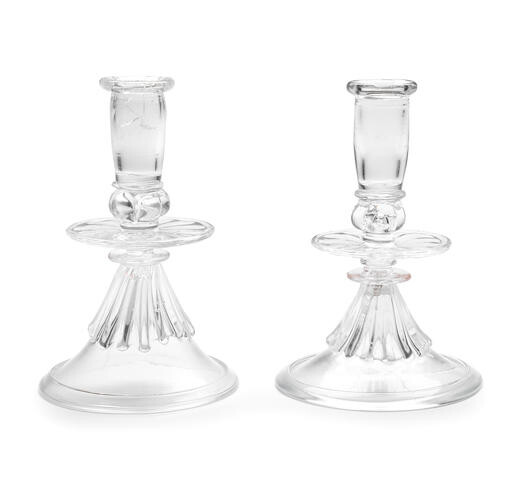An exceptional pair of early glass candlesticks, probably French, late 17th century
Perhaps Bernard Perrot, Orléans, with cylindrical nozzles folded at the rims, resting on collars above solid quatrefoil knops containing small tears, the broad drip pans set between knops and moulded with twelve radiating ribs to the undersides, set on a wide collars above tall spreading feet moulded with fourteen gadroons to the upper parts, the rims of the drip pans and feet folded over, 18.5cm and 18.7cm high (2)
Provenance
Sotheby's sale, 23 June 1944, lot 65
No other similar candlesticks would appear to be recorded in the literature. The solid quatrefoil knops have a very slight cloudy appearance of the metal, with very close similarities to a series of ewers or jugs attributed to Bernard Perrot (1640-1709), a glassmaker of Italian origin who was active in Orléans from 1662, see the exhibition catalogue, Bernard Perrot 1640-1709 (2010), p.141, nos.77 and 78 and pp.148-9, no.101. A similar jug in latticinio attributed to English manufacture is illustrated by Dwight P Lanmon, The Golden Age of English Glass (2011), pp.60-1, no.1 and was sold by Bonhams on 20 May 2015, lot 21.
Lanmon notes on p.61 that solid quatrefoil knops occur in glass produced in both France and the Netherlands in the late 17th century, but not in Venetian glass. Whilst an English origin for these candlesticks cannot be ruled out, the upturned footrims are more typical of French production. A bowl moulded with a series of radiating ribs stylistically very similar to the drip pans on these candlesticks, also attributed to Perrot, is illustrated in the 2010 catalogue, p.143, no.89.
A pair of crizzled candlesticks which may be of related production was sold by Bonhams on 2 May 2018, lot 9 and another was exhibited by Alan Tillman, see the catalogue, Glass Through the Ages (1974), p.18, no.28.
View it on
Estimate
Time, Location
Auction House
Perhaps Bernard Perrot, Orléans, with cylindrical nozzles folded at the rims, resting on collars above solid quatrefoil knops containing small tears, the broad drip pans set between knops and moulded with twelve radiating ribs to the undersides, set on a wide collars above tall spreading feet moulded with fourteen gadroons to the upper parts, the rims of the drip pans and feet folded over, 18.5cm and 18.7cm high (2)
Provenance
Sotheby's sale, 23 June 1944, lot 65
No other similar candlesticks would appear to be recorded in the literature. The solid quatrefoil knops have a very slight cloudy appearance of the metal, with very close similarities to a series of ewers or jugs attributed to Bernard Perrot (1640-1709), a glassmaker of Italian origin who was active in Orléans from 1662, see the exhibition catalogue, Bernard Perrot 1640-1709 (2010), p.141, nos.77 and 78 and pp.148-9, no.101. A similar jug in latticinio attributed to English manufacture is illustrated by Dwight P Lanmon, The Golden Age of English Glass (2011), pp.60-1, no.1 and was sold by Bonhams on 20 May 2015, lot 21.
Lanmon notes on p.61 that solid quatrefoil knops occur in glass produced in both France and the Netherlands in the late 17th century, but not in Venetian glass. Whilst an English origin for these candlesticks cannot be ruled out, the upturned footrims are more typical of French production. A bowl moulded with a series of radiating ribs stylistically very similar to the drip pans on these candlesticks, also attributed to Perrot, is illustrated in the 2010 catalogue, p.143, no.89.
A pair of crizzled candlesticks which may be of related production was sold by Bonhams on 2 May 2018, lot 9 and another was exhibited by Alan Tillman, see the catalogue, Glass Through the Ages (1974), p.18, no.28.



